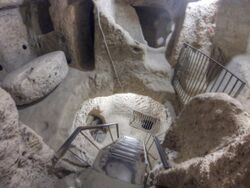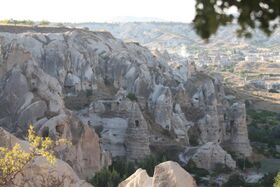Religion:Rûm
Rûm (Arabic pronunciation: [ˈruːmˤ]; singular Rûmi), also transliterated as Roum (in Arabic الرُّومُ ar-Rûm; in Persian and Ottoman Turkish روم Rûm; in Turkish: Rum), is a derivative of the Middle Persian term hrōm, itself ultimately derived from Greek Ῥώμη. The latter was an endonym of the pre-Islamic inhabitants of Anatolia, the Middle East, and the Balkans, dating to when those regions were parts of the Byzantine (Eastern Roman) Empire.
The term Rûm is now used to describe:
- Remaining pre-Islamic ethnocultural Christian minorities living in the Near East and their descendants, notably the Antiochian Greek Christians who are members of the Greek Orthodox Church of Antioch and the Melkite Greek Catholic Church of Syria, Lebanon, Jordan, Israel, Palestine, and the Hatay Province in Southern Turkey whose liturgy is still based on Koine Greek.
- Orthodox Christian citizens of modern Turkey originating in the pre-Islamic (pre-Turkic invasion) native peoples of the country, including Pontians from the Black Sea mountains in the north, Cappadocians from Turkey's central plateau, and Hayhurum from eastern Turkey. However, use of the term in Turkey is rapidly disappearing, apart from small remaining communities in Istanbul, due to the genocides and expulsions of these indigenous groups throughout the 20th century, in particular the genocide of the minorities of Turkey in the 1920s and the subsequent persecutions of the 1940s and 1950s.
- Topographical names within Anatolia (e.g. Erzurum and Rumiye-i Suğra) and the Balkans (Rumelia) stemming from the legacy of the Eastern Roman (Byzantine) Empire in those areas, or of the Seljuk Sultanate of Rûm, a medieval Muslim state that ruled over recently conquered Byzantines (Rûm) in central Asia Minor from 1077 to 1308.
History
The term "Rûm" in Arabic and New Persian was derived from Middle Persian hrōm, which had in turn derived from the connected Aramaic ܪܗܘܡܐ/רהומא (rhōmī) and Parthian frwm which was used to label "Rome" and "Roman Empire" and which was derived from the Greek Ῥώμη. The Armenian and Georgian forms of the name was also derived from Parthian.[lower-alpha 1]
Rûm is found in the pre-Islamic Namara inscription[2] and later in the Quran (7th century), where it is used to refer to the contemporary Byzantine (Eastern Roman) Empire under its then Greek-speaking emperors (Heraclian dynasty). The empire was the most prominent Christian state during the period of Muhammad's life and during the composition of the Quran, since the Western Roman Empire had fallen two centuries earlier in the 5th century.[3]
The Qur'an includes the Surat Ar-Rum, the sura dealing with "the Romans", sometimes translated as "The Byzantines," reflecting a term now used in the West. These Romans of the 7th century, referred to as Byzantines in modern Western scholarship, were the inhabitants of the surviving Eastern Roman (Byzantine) Empire. Since all ethnic groups within the Roman empire had been granted citizenship by 212 AD, these eastern peoples had come to label themselves Ρωμιοί or Ῥωμαῖοι Romaioi (Romans), using the word for Roman citizen in the eastern lingua franca of Koine Greek. This citizenship label became "Rûm" in Arabic. To differentiate the inhabitants of the western city of Rome the Arabs used instead the word "Rūm" or sometimes "Latin'yun" (Latins), and to differentiate ancient Greek speakers the term "Yūnānīm" was used from "Yūnān" (Ionia), the name for Greece. The word "Byzantine," which is now used by Western historians to describe the Eastern Roman Empire and its Greek lingua franca, was not used anywhere at the time.
The Roman and later Eastern Roman (Byzantine) state encompassed the entirety of the eastern Mediterranean for six centuries, but following the advent of Islam in Arabia in the 7th century, and the subsequent Islamic conquest of what is now Syria, Egypt, and Libya in the 7th-8th centuries AD, the Byzantine state shrank to consist only of Anatolia and the Balkans in the Middle Ages. In the early Renaissance (15th century) the Byzantine state finally fell to muslim Turkic conquerors, who had begun migrating into what is now Turkey from Central Asia during the 12th-14th centuries. Thus, during the Middle Ages the Arabs called the native inhabitants of what is now Turkey, the Balkans, Syria, Lebanon, and Palestine "Rûm" (literally Romans, but in modern historiography often called Byzantine subjects), and called what is now Turkey and the Balkans "the land of the Rûm," while referring to the Mediterranean as "the Sea of the Rûm".
After the fall of the Byzantine state in 1453, the Ottoman Turkish conqueror Sultan Mehmed II declared himself to have replaced the Byzantine (Eastern Roman) ruler as the new Kayser-i Rum, literally "Caesar of the Romans". In the Ottoman Millet system, the conquered natives of Turkey and the Balkans were now categorized as the "Rum Millet" (Millet-i Rum) for taxation purposes and were allowed to continue practicing Orthodox Christianity, the religion promulgated by the former Byzantine state. In modern Turkey Rum is still used to denote the Orthodox Christian native minority of Turkey, together with its pre-conquest remnant institutions, cf. Rum Ortodoks Patrikhanesi, the Turkish designation of the Istanbul-based Ecumenical Patriarchate of Constantinople, the figurehead for all of Orthodox Christianity and former religious leader of the Eastern Roman state.
Rûm in geography
Muslim contact with the Byzantine Empire most often took place in Asia Minor (the bulk of what is part of Turkey), since it was the heartland of the Byzantine state from the early Middle Ages onward, so the term Rûm became fixed there geographically. The term remained even after the conquest of what is now central Turkey in the late Middle Ages by Seljuk Turks, who were migrating from Central Asia. Thus, the Turks called their new state the Sultanate of Rûm, the "Sultanate of the Rome."
After the Ottoman conquest of the Balkans the area was called Rumelia (Roman lands) as it was predominantly inhabited by the newly conquered nation (Byzantines) that the Ottomans called Rûm.
Rûm as a name
Al-Rūmī is a nisbah designating people originating in the Byzantine (Eastern Roman) Empire or lands that formerly belonged to Byzantine (Eastern Roman) Empire, especially the lands that are now called Turkey. Historical people so designated include the following:
- Suhayb ar-Rumi, a companion of Muhammad
- Harithah bint al-Muammil (Zunairah al-Rumiya), a companion of Muhammad
- Rumi a moniker for Mawlānā Jalāl-ad-Dīn Muhammad Balkhī, the 13th-century Persian poet who lived most of his life amongst the conquered Rûm (Byzantines) of Konya (Byzantine Greek: Ἰκόνιον or Ikonio) in the Sultanate of Rûm
- Qāḍī Zāda al-Rūmī, 14th-century mathematician
- Tadj ol-Molouk Ayrumlu, Former Queen of Iran
The Greek surname Roumeliotis stems from the word Rûm borrowed by Ottomans.[citation needed]
Other uses
During the 16th century, the Portuguese used "rume" and "rumes" (plural) as a generic term to refer to the Mamluk-Ottoman forces they faced then in the Indian Ocean.[4]
The term "Urums", also derived from the same origin, is still used in contemporary ethnography to denote Turkic-speaking Greek populations. "Rumeika" is a Greek dialect identified mainly with the Ottoman Greeks.[citation needed]
Chinese, during the Ming dynasty, referred to the Ottomans as Lumi (魯迷), derived from Rum or Rumi. The Chinese also referred to Rum as Wulumu 務魯木 during the Qing dynasty. The modern Mandarin Chinese name for the city of Rome is Luoma (羅馬).[citation needed]
Among the Muslim aristocracy of South Asia, the fez is known as the Rumi Topi (which means "hat of Rome or Byzantium").[5]
Non-Ottoman Muslims in the classical period used to call Ottomans as Rumis due to the Byzantine legacy inherited by the Ottoman Empire. [6]
In the Sassanian period (pre-Islamic Persia) the word Hrōmāy-īg (Middle Persian) meant "Roman" or "Byzantine", which was derived from the Byzantine Greek word Rhomaioi.[citation needed]
See also
- Ayrums, a Turkic tribe which derives their name from the word Rûm
- Urums, Turkophone Hellenic people
- Edirne Ciğeri, a meat dish found in Turkey also referred to as "Rumeli Ciğeri"
- Erzurum, from the Turkish pronunciation of Arabic أرض روم arḍ Rūm or أرض الروم arḍ ar-Rūm, 'Land of the Romans'
- Hayhurum, Greek Orthodox Armenians of Turkey
- Rûm Eyalet
- Rumelia, from Turkish Rum eli meaning 'country of the Romans'
- Rumi calendar, a calendar based on the Roman Julian Calendar, used by the Ottoman Empire after Tanzimat
- Rumiye-i Suğra, or Little Rûm (Rome), is the name of the region in Ottoman Empire which included Tokat, Amasya, and Sivas
- Rumçi, another term used to refer to the Greek Orthodox during the Ottoman times
- Romaniote Jews
- Succession of the Roman Empire
- Baciyan-i Rum
Notes
- ↑ "It was the Parthian and Aramaic form that subsequently was borrowed by the Pahlawi, Armenian, Georgian, Arabic and finally Neo-Persian and Turkish languages. [...] The Arabic and New Persian languages inherited the Pahlawi hrōm with the omission of the aspirated component in the Ancient Greek rho."[1]
References
- ↑ Shukurov 2020, p. 145.
- ↑ Rûm, Nadia El Cheikh, The Encyclopaedia of Islam, Vol. VIII, ed. C.E. Bosworth, E. Van Donzel, W.P. Heinrichs and G. Lecomte, (Brill, 1995), 601.
- ↑ Nadia Maria El-Cheikh, Byzantium Viewed by the Arabs, (Harvard University Press, 2004), 24.
- ↑ Ozbaran, Salih, "Ottomans as 'Rumes' in Portuguese sources in the sixteenth century", Portuguese Studies, Annual, 2001. "Alternate link."
- ↑ The "Rumi Topi" of Hyderabad, by Omair M. Farooqui
- ↑ Ozbaran, Salih, "Ottomans as 'Rumes' in Portuguese sources in the sixteenth century", Portuguese Studies, Annual, 2001. "Alternate link."
Bibliography
Further reading
- Durak, Koray (2010). "Who are the Romans? The Definition of Bilād al-Rūm (Land of the Romans) in Medieval Islamic Geographies". Journal of Intercultural Studies 31 (3): 285–298. doi:10.1080/07256861003724557.
- Kafadar, Kemal (2007). "Introduction: A Rome of One's Own: Reflections on Cultural Geography and Identity in the Lands of Rum". Muqarnas 24: 7–25.
- Kaldellis, Anthony (2019). Romanland: Ethnicity and Empire in Byzantium. Harvard University Press. ISBN 978-0674986510.
- Shukurov, Rustam (2020). "Grasping the Magnitude: Saljuq Rum between Byzantium and Persia". The Seljuqs and their Successors: Art, Culture and History. Edinburgh University Press. pp. 144–162. ISBN 978-1474450348. https://books.google.com/books?id=46MxEAAAQBAJ&dq.
External links




